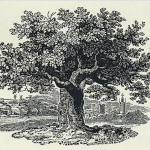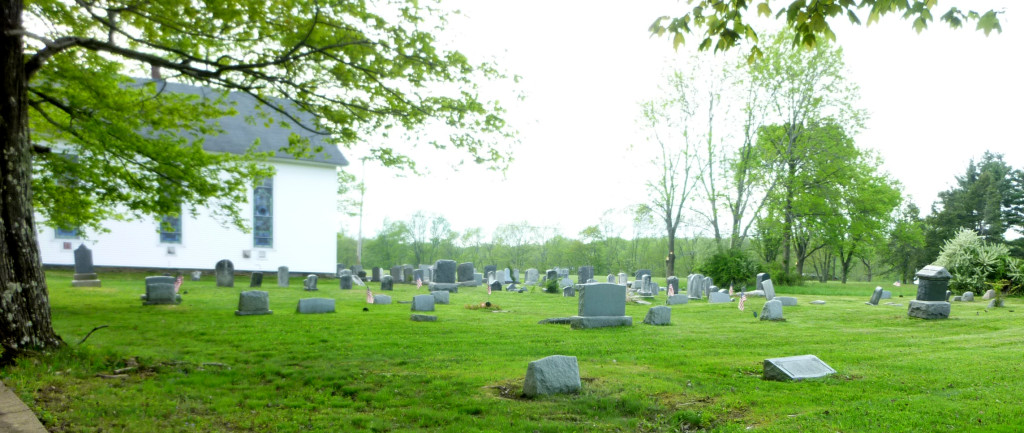This is a continuation of my history of the ownership of the Rittenhouse Tavern. The previous article covered the period of time when members of the Rittenhouse family owned the tavern. The following article looks at the subsequent history, starting with James Wolverton and Mary Ann Sergeant in 1843, George Hoppock and Jane Elizabeth Wolverton in 1868 and Lambert B. Mathews and Lizzie Nixon in 1910, and ending with Frank W. Reading and Charlotte Venable in 1922.
Hoppock
HOPPOCK. Originally the name of this German immigrant family was spelled Happaugh or Hausbach. Johann George Hoppock and wife Anna Magdalena settled in Lebanon Township around 1730. The family soon acquired large acreage there and in Amwell Township, and had numerous descendants.
The Hoppock Family Tree
 Johann George Hoppough and wife Anna Magdalena came from Seelbach, Germany to Hunterdon County with their six children. They settled in Lebanon Township and worshipped at the Readington Reformed Church. In 1745, “Jurey Happach” became a naturalized New Jersey citizen. The best source for information on this immigrant family is More Palatine Families by Henry Z. Jones.
Johann George Hoppough and wife Anna Magdalena came from Seelbach, Germany to Hunterdon County with their six children. They settled in Lebanon Township and worshipped at the Readington Reformed Church. In 1745, “Jurey Happach” became a naturalized New Jersey citizen. The best source for information on this immigrant family is More Palatine Families by Henry Z. Jones.
Like many other family names, this one was spelled in a variety of ways: Habbaugh, Hausbach, Hopbach, Hobbach, Hoppaugh are just a few.
An Old Account Book
I am publishing this article now because it ties in with the other articles I have recently written about residents of or near the village of Sandbrook in Delaware Township. This is one of Mr. Bush’s articles that could be taken as an historical document in itself, because it includes the contents of two old records—an account book from the 1830s and an old family bible.
Hoppock Farm Over 600 Acres
Not long ago I published some articles about properties located in what was once known as The Haddon Tract (The Haddon Tract, part one). Today’s article by Egbert T. Bush concerns a very large farm located in that tract that I have not yet written about. It was sold by Jacob Sniter and Nicholas Sayn to John Peter Foxe of Amwell, who subsequently sold it to Jost Hoppock in 1749.
Sen. Lambert’s Farm, pt 2
A continuation of the article on Sen. John Lambert’s home farm.
Having discovered which of two farms belonged to Sen. John Lambert, I realized how amazingly interconnected the Lambert family was. That will hold true even more so here in part two. However, I have not done all the research that could have been done before publishing this article. It was a question of when to stop.
1863 Politics in Delaware Township
This article is a follow-up to the Democratic Club of Delaware Township, published last spring.
The previous article described the Club’s principles and resolutions, reflecting the alarm felt by Hunterdon Democrats at the war measures taken by President Lincoln. The article was published in the Hunterdon Historical Newsletter.1 But because of length restrictions, short biographies of the club’s officers had to be postponed to a future newsletter.
Milling Industry at Prallsville Back of Year 1792
Little Known of Mill That Existed Prior to John Prall’s
When the Canal Was Dugby Egbert T. Bush, Stockton, N.J.
published in the Hunterdon County Democrat, February 13, 1930It is common to speak of John Prall Jr. as the builder of the first mill in this hamlet. But his titles date back to early 1792; and to some of us it seemed strange that a site so attractive with the Wickecheoke Creek rushing into the Delaware, with an established ferry close at hand, and with a solid community back of it should have been so long without a mill. While investigation has so far failed to reveal all that was hoped for, it has demonstrated that Prall was far from being first to carry on milling business here.
The Locktown Christian Church Cemetery

As a follow-up to my recent article on the history of the Locktown Christian Church, here is a list of the people known to be buried in the cemetery adjacent to the church.
A visit to this interesting cemetery will quickly reveal that there are many graves here that are unmarked. So it is impossible to know who might be the earliest person buried here. The earliest gravestone is for Charity Alley who died in 1843, although Cornelius Williamson Carrell might have died a couple years before that. Oddly enough, Ms. Alley comes first on the list. The last known grave to be added was for Arthur E. Jungblut in 1999.
Historic Hunterdon Church For Sale
Once Known as the Locktown Christian Church
Near the center of the village of Locktown stands a 19th-century church and its parsonage, waiting for a new owner. The congregation that has been worshipping in this church for the past 30 years or so is joining with the Calvary Orthodox Presbyterian Church on Route 202 in Flemington, so the Locktown property must be sold.
Part II, Delaware Twp. Officers, 1838
Overseers of Roads
At the first town meeting, the Township Committee voted that $1,000 was to be raised for making and repairing roads. Municipalities were responsible for their roads, while the county took responsibility for the bridges. Generally, it was the landowners along the roads who maintained them, so you can imagine what condition they were in: dust in the summer, mud in the spring and downright impassible in the winter, unless you had a sleigh. The township named many people to be Overseers of Roads. It’s hard to say exactly what their responsibilities were. Most likely, they managed the work that was ordered by the Surveyors of Highways.